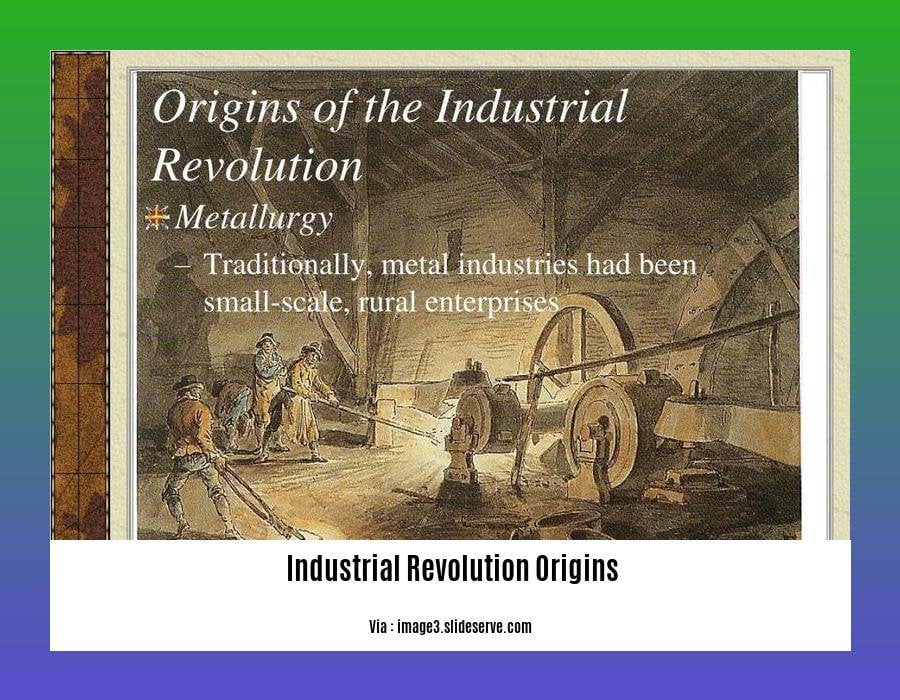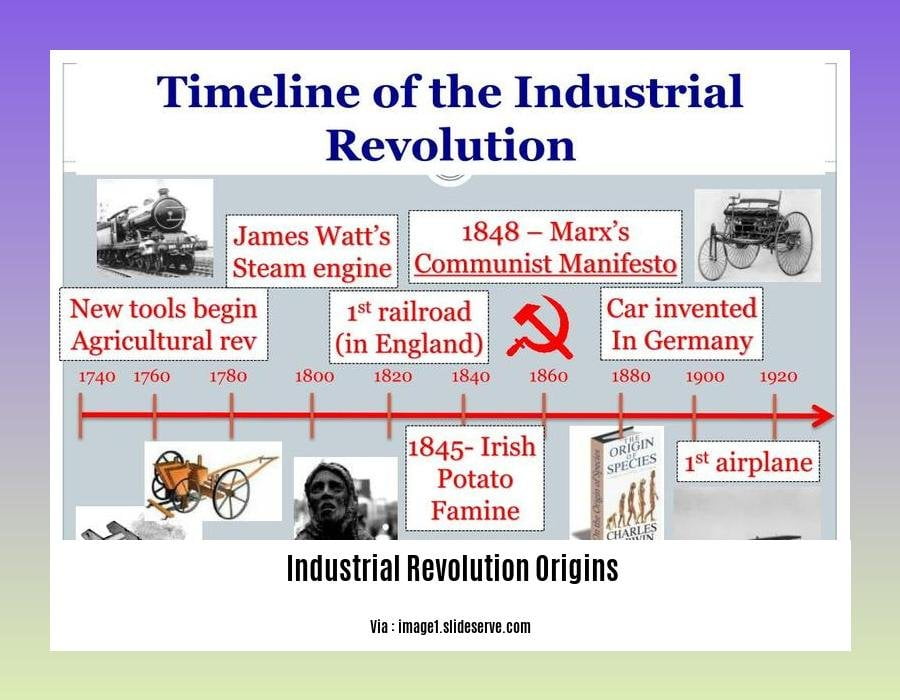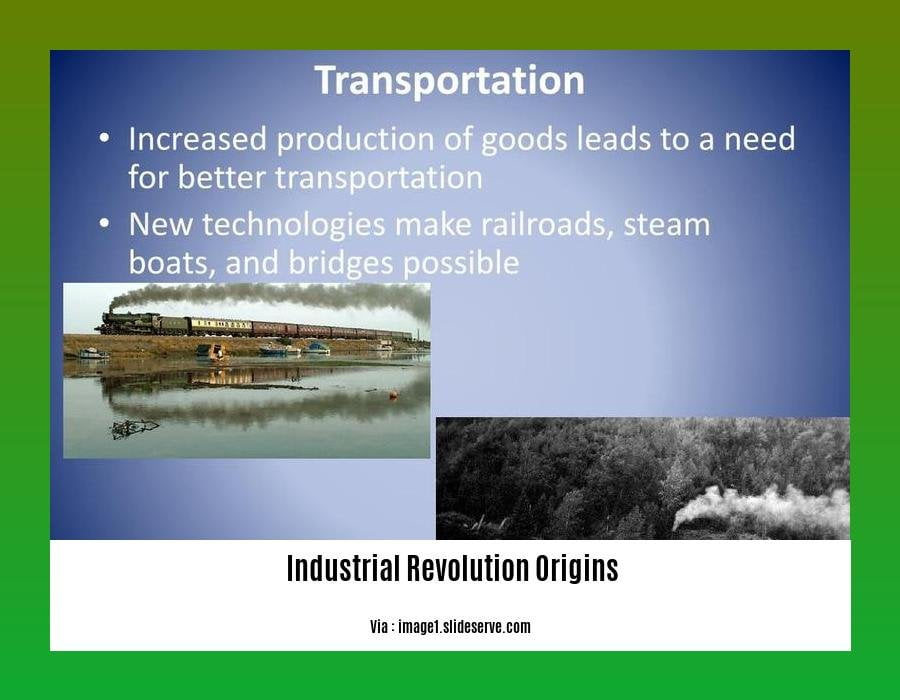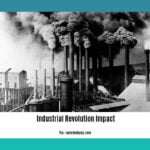Delve into the origins of the Industrial Revolution in [- Unraveling the Origins of the Industrial Revolution: A Historical Perspective]. This article explores the technological innovations, economic transformations, and social upheavals that ignited the industrial era, shaping our world in profound ways.
Key Takeaways:
- The Industrial Revolution was a transformative period that began in the 18th century, marked by rapid technological, economic, and social changes.
- It originated in Great Britain due to its abundant resources, infrastructure, and technological innovations (steam engine, spinning jenny, etc.).
- These innovations led to increased productivity and mechanization, transforming agrarian societies into industrialized ones.
- The social impacts of the Industrial Revolution included urbanization, the rise of factory systems, and widening income gaps.
- The revolution began around 1750 and lasted until the mid-19th century, with its effects continuing to shape society afterward.
Industrial Revolution origins

The Industrial Revolution, a period of profound change, began in Great Britain in the mid-18th century. Its roots lie in a confluence of factors, including technological advancements, economic shifts, and societal transformations.
Technological Catalyst
Advances in technology played a pivotal role in the onset of the Industrial Revolution. The steam engine, invented by Thomas Savery in 1698 and later perfected by James Watt, provided a reliable source of power for factories. The spinning jenny, developed by James Hargreaves in 1764, revolutionized textile production by enabling the spinning of multiple threads simultaneously.
Economic Factors
Economic conditions also fostered the Industrial Revolution. Britain’s abundant natural resources, particularly coal and iron, provided the raw materials for industrial growth. The expansion of trade and the rise of capitalism created a demand for increased production, driving the need for technological innovation.
Social Upheavals
The Industrial Revolution brought significant social changes. The growth of factories led to the urbanization of populations and the emergence of a working class. New forms of social organization, such as labor unions, emerged to address the challenges faced by industrial workers.
Key Inventions of the Industrial Revolution
| Invention | Inventor | Year | Impact |
|---|---|---|---|
| Steam Engine | Thomas Savery | 1698 | Provided reliable power for factories |
| Spinning Jenny | James Hargreaves | 1764 | Revolutionized textile production, increasing efficiency |
| Power Loom | Edmund Cartwright | 1785 | Automated weaving process, further boosting textile production |
| Cotton Gin | Eli Whitney | 1793 | Mechanized the removal of seeds from cotton, spurring cotton cultivation and textile manufacturing |
| Telegraph | Samuel Morse | 1837 | Facilitated rapid communication over long distances, connecting industrial centers |
The Industrial Revolution origins are a complex and multifaceted phenomenon that transformed society and set the stage for the modern world. By understanding the technological, economic, and social factors that sparked this pivotal change, we gain insights into the processes that have shaped human history and continue to influence the world today.
- Delve into the History of England to uncover the captivating narrative of this remarkable nation.
- Explore the pivotal events of the Roman conquest of Britain, when the legions of the mighty Roman Empire transformed the landscape of the British Isles.
- Witness the transformative impact of the Norman Conquest, a pivotal moment that forever altered the course of English history.
Rise of Factories: A Cornerstone of the Industrial Revolution

The burgeoning Industrial Revolution witnessed a profound transformation in manufacturing techniques, marked by the rise of factories. These centralized production hubs emerged as the engines driving the era’s economic and societal shifts.
Factors Fueling the Rise of Factories:
- Technological Advancements: Inventions like the steam engine and spinning jenny revolutionized production processes, increasing efficiency and output.
- Expanding Markets: Growing consumer demand for goods fueled the need for increased production capabilities, which factories provided.
- Urbanization: As populations concentrated in cities, factories became essential for meeting the demands of growing urban centers.
Impact of Factories on Production:
- Mass Production: Factories enabled the production of goods in unprecedented quantities, meeting the burgeoning demand for consumer goods.
- Division of Labor: Production processes were broken down into specialized tasks, resulting in greater efficiency and productivity.
- Technological Integration: Factories integrated various machines and processes under one roof, streamlining production and reducing costs.
Social Impact of Factories:
- Urbanization: Factories attracted workers from rural areas, leading to rapid urbanization and the growth of cities.
- Labor Conditions: Factory work often involved long hours and harsh conditions, giving rise to labor movements and the fight for better working conditions.
- Social Divisions: The Industrial Revolution created a divide between factory owners and the working class, leading to social tensions and class struggles.
Key Takeaways:
- The rise of factories was a defining characteristic of the Industrial Revolution.
- Factories enabled mass production, specialization of labor, and technological integration.
- The growth of factories fueled urbanization and had a significant impact on labor conditions and social dynamics.
Relevant Sources:
Social Upheavals: A Consequence of the Industrial Revolution
The Industrial Revolution brought more than just machines and factories; it reshaped the very fabric of society. As the countryside emptied into cities and new industries emerged, traditional ways of life were uprooted, leading to profound Social Upheavals.
Defining the Social Upheaval
The Industrial Revolution saw a massive shift from rural to urban living. People flocked to cities to work in factories, creating densely populated urban centers with poor sanitation and living conditions. This led to a decline in traditional family structures, an increase in social inequality, and the emergence of a working class.
Impacts on Work and Daily Life
The mechanization of labor drastically altered work patterns. Factory work was characterized by long hours, low pay, and dangerous conditions. Children and women entered the workforce en masse, reshaping gender roles and family dynamics. The distinction between work and home life blurred as factories occupied central roles in urban communities.
Rise of New Ideas
The Industrial Revolution challenged traditional beliefs. New economic theories, such as capitalism, emphasized individual profit over collective well-being. Philosopher Thomas Malthus argued that population growth would outpace food production, leading to widespread poverty. These ideas laid the groundwork for social and political movements, including labor unions and calls for social reform.
Key Takeaways:
- Urbanization resulted in overcrowded cities with poor living conditions.
- Emergence of a working class created social inequality and labor tensions.
- Mechanization of labor altered work patterns and gender roles.
- New economic and philosophical ideas challenged traditional beliefs.
Sources:
- Britannica: Social Impact of the Industrial Revolution
- Encyclopedia.com: The Industrial Revolution and Social Change
Environmental Impact
The Industrial Revolution brought immense progress, but its Environmental Impact was significant. The mass production and consumption of goods led to:
Air and Water Pollution
Factories spewed pollutants like soot and chemicals into the air, while industrial waste contaminated rivers and streams. The result was severe air and water pollution, affecting human health and ecosystems.
Depletion of Resources
Industrialization required vast amounts of resources, leading to deforestation, mining, and soil degradation. The depletion of these resources had long-term consequences for the environment.
Greenhouse Gas Emissions
The burning of fossil fuels to power factories and transportation released greenhouse gases, contributing to global warming. This has been a major driver of climate change and its associated impacts.
Key Takeaways:
- The Industrial Revolution exacerbated Environmental Impact through pollution, resource depletion, and greenhouse gas emissions.
- Air and water pollution harmed human health and ecosystems.
- Resource depletion had long-term environmental consequences.
- The burning of fossil fuels contributed to global warming and climate change.
Relevant URL Sources:
- The Industrial Revolution’s Environmental Impact
- Industrial Revolution and Pollution: A Historical Perspective
FAQ
Q1: When did the Industrial Revolution begin?
A1: The Industrial Revolution began around 1750 in Great Britain.
Q2: What factors contributed to the Industrial Revolution?
A2: The availability of abundant mineral resources, coal reserves, and a developed infrastructure in Great Britain played a significant role in the onset of the Industrial Revolution.
Q3: What were the key technological innovations of the Industrial Revolution?
A3: Key innovations included the steam engine, spinning jenny, power loom, and cotton gin, which increased productivity and mechanization.
Q4: What social changes occurred during the Industrial Revolution?
A4: The Industrial Revolution led to urbanization as people moved to cities for factory work, and the rise of factory systems and widening income disparities.
Q5: How did the Industrial Revolution impact the environment?
A5: The Industrial Revolution resulted in widespread pollution, reduction in biodiversity, and global warming due to the increased production and consumption of materials and the release of harmful pollutants.
- Amazing March Fun Facts: Unveiling History & Celebrations - April 15, 2025
- Master how to write height: A complete guide - April 15, 2025
- How High Are Your Standards Test: Find Your Perfect Match Now - April 15, 2025
















